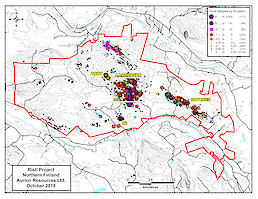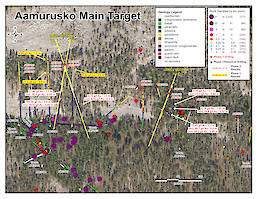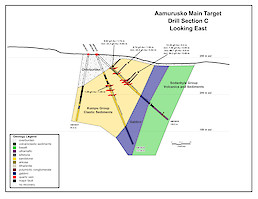Aurion Resources Provides Update on 2018 Exploration Campaign
Aurion Resources Ltd. (TSX VENTURE:AU) (“Aurion” or the “Company”) is pleased to provide an update on its surface exploration and drilling program at its Risti Project in northern Finland.
Summary
- Hole 51, 25m down dip of Hole 42 encountered a vein which assayed 17.5g/t Au over 1.1m at the Aamurusko Main target
- 10 drillholes within the vicinity of Hole 42 have been drilled to date, 5 have assays pending
- Diamond drilling continues at Risti with a 3rd diamond drill rig being added in 7-10 days
- Assays from trenching are pending for several key targets including Ynot and Notches
A total of 44 drill holes and 6,297 metres (m) of 15,000 m planned have been completed since early July. Assays have been received for 36 drillholes to date. Assays are pending for an additional 8 drillholes. Four targets were tested including Aamurusko Main, Aamurusko West, Aamurusko NW and A2. Diamond drilling with two drills continues at Aamurusko Main target area. A third drill has been added and is anticipated to arrive in 7-10 days. A summary of assay results received to date are presented in a table and further discussed below. Maps and sections can be found on Aurion’s website by clicking the following link https://aurionresources.com/site/assets/files/1256/nr221018figures.pdf.
Extensive trenching has been conducted over a distance of more than 8 km from YNot to the Notches area. A total of 40 individual trenches have been excavated, mapped and channel sampled. Assays are pending for the majority and will be compiled accordingly. Trenching has confirmed that many boulder sources are in bedrock immediately beneath or proximal. This is common across Risti. Many more targets remain to be trenched and this will continue in spring 2019. Several trench targets will be drill tested during the current campaign.
Over 4,000 prospecting rock samples have been collected across the Risti property to date. Only 25-30% of the 15,000 ha Risti property has been systematically prospected. Many new targets have been identified for further follow-up.
Aamurusko Main Target Drilling
Drilling continues to intersect quartz veins occurring proximal to the sheared contact between clastic sediments of the Kumpu Group and a gabbro sill on the contact between the Kumpu Group and mafic and ultramafic volcanics of the Sodankyla Group, immediately north of the Aamurusko boulder field. However, current structural geological interpretation indicates a complex mineralizing system, which is often typical of orogenic gold systems. With only 10 drillholes into the main target and assays received for only 5, the structural controls on mineralization are still not fully understood.
Ten (10) drillholes have been completed over strike of approximately 100 m in the vicinity of drillhole AM18042 where a 2.90 m wide fault fill vein with coarse visible gold was intersected. It assayed 789.06 g/t Au over 2.90 m from 116.10 to 119.00 m including 0.65 m assaying 3,510.00 g/t Au (See press release dated Sept 19, 2018). Two additional drillholes, AM18051 and 054 were completed on the same section as AM18042, intersecting quartz veining on the sheared contact between gabbro and clastic sediments. The best result was of a shear vein in drillhole AM18051 which assayed 17.46 g/t Au over 1.1 m including 39.4 g/t Au over 0.45 m within an approximate 3 m wide vein zone, 25 m downdip of the AM18042 intercept. AM18054 a further 25 m downdip intercept intersected a 4.7 m wide chaotic vein zone at the contact but with only weakly anomalous values.
Drillholes AM18052 and 53 were drilled from the same setup as 42, 51 and 54 but at a southeasterly azimuth to test the target approximately 35 m to the east. Multiple extensional and stockwork or breccia vein zones were encountered throughout hole AM18052. Only anomalous values were encountered including a best assay result of 0.53 g/t Au over 0.55 m right at the contact.
Drillhole AM18053 intersected a 3.5 m wide breccia vein zone from 102.00 to 105.50 m in clastic sediments with anomalous gold values throughout including 3.07 g/t Au over 0.53 m. No significant quartz veining was encountered at the gabbro contact. A new zone of gold mineralization comprising quartz carbonate veins and stringers with several percent arsenopyrite, galena and sphalerite was intersected at 196.1 to 203.7 m depth in the gabbro. The best assay result was 4.76 g/t Au over 1.2 m including 9.12 g/t Au over 0.5 m.
Four drillholes, AM18055, 56, 58 and 61, on two fences were drilled to test the target 55 and 75 m to the west of the intercept in drillhole AM18042. Assays are pending for these drillholes.
Approximately 230 m east of AM18042 seven drillholes AM18032-38 were completed in the area of drillhole AM18035 which intersected mineralization including a 5.20 m wide zone assaying 12.45 g/t Au from 53.50 to 58.70 m downhole including 66.70 g/t Au over 0.50 m, and 54.3 g/t over 0.49 m. Further up hole a 1.55 m wide quartz vein zone from 36.65 to 38.20 m assayed 8.74 g/t Au and from 26.30 to 28.04 m a 1.74 m wide quartz vein zone assayed 9.62 g/t Au. Drillholes AM18060 and 62 were designed as further tests of the mineralization in AM18035 but hole Am18060 had to be abandoned due to bad ground conditions.
Drillholes AM18059 and 057 were 100 m and 500 m step-outs to the east of AM18035 respectively. Assays are pending for these drillholes.
| Aamurusko Drillhole Summary Table | |||||
| HOLE_ID | FROM_m | TO_m | Width_m | Au_ppm (g/t) | Comments |
| Aamurusko Main Target | |||||
| AM18032 | 151.65 | 151.97 | 0.32 | 1.83 | |
| AM18033 | 68.50 | 70.50 | 2.00 | 1.45 | |
| AM18034 | 49.76 | 50.66 | 0.90 | 0.85 | |
| AM18035 | 26.3 | 28.04 | 1.74 | 9.62 | |
| incl | 26.3 | 26.94 | 0.64 | 23.30 | |
| AND | 36.65 | 38.20 | 1.55 | 8.74 | |
| incl | 37.18 | 37.7 | 0.52 | 24.80 | |
| AND | 53.50 | 58.70 | 5.20 | 12.45 | |
| incl | 53.50 | 54.05 | 0.55 | 7.46 | |
| incl | 54.50 | 55.00 | 0.50 | 66.70 | |
| incl | 57.65 | 58.14 | 0.49 | 54.30 | |
| AM18036 | 45.23 | 47.08 | 1.85 | 1.29 | |
| AM18037 | NSV | Lost in fault | |||
| AM18038 | NSV | Didn’t reach target | |||
| AM18042 | 69.91 | 72.00 | 2.09 | 1.74 | |
| AND | 90.15 | 91.00 | 0.86 | 3.52 | |
| AND | 116.10 | 119.00 | 2.90 | 789.06 | |
| incl | 116.10 | 116.75 | 0.65 | 3510.00 | 1.1 m of lost core from 116.75 to 117.85 m; assigned a value of 0 ppm |
| incl | 117.85 | 119.00 | 1.15 | 5.89 | |
| AM18051 | 114.30 | 115.40 | 1.10 | 17.46 | 25 m downdip undercut of 42 |
| incl | 114.30 | 114.95 | 0.65 | 2.27 | |
| incl | 114.95 | 115.40 | 0.45 | 39.4 | |
| AM18052 | 70.00 | 70.55 | 0.55 | 1.77 | Wide zones of anomalous quarz stockwork and breccia veins |
| AND | 93.77 | 96.35 | 2.58 | 0.36 | |
| incl | 93.77 | 94.50 | 0.73 | 0.96 | |
| AND | 107.45 | 108.00 | 0.55 | 0.53 | |
| AM18053 | 102.80 | 103.33 | 0.53 | 3.07 | |
| AND | 196.10 | 196.60 | 0.50 | 1.39 | Highly anomalous As-Pb-Zn |
| AND | 202.50 | 203.70 | 1.20 | 4.76 | Highly anomalous As-Pb-Zn |
| incl | 202.50 | 203.00 | 0.50 | 9.12 | |
| incl | 203.00 | 203.35 | 0.35 | 2.39 | |
| AM18054 | NSV | ||||
| AM18055 | Assays Pending | ||||
| AM18056 | Assays Pending | ||||
| AM18057 | Assays Pending | ||||
| AM18058 | Assays Pending | ||||
| AM18059 | Assays Pending | ||||
| AM18060 | Abandoned | Abandoned | |||
| AM18061 | Assays Pending | ||||
| AM18062 | Assays Pending | ||||
| AM18063 | Assays Pending | ||||
| Aamurusko West Target | |||||
| RB18001 | NSV | Only anomalous values up to 0.57 g/t over 0.50 m intersected in RB18001 - RB18004 | |||
| RB18002 | NSV | ||||
| RB18003 | NSV | ||||
| RB18004 | NSV | ||||
| Aamurusko NW Target | |||||
| AM18024 | 227.00 | 228.00 | 1.00 | 4.17 | |
| AM18025 | 136.00 | 137.00 | 1.00 | 0.51 | |
| AM18026 | 181.90 | 182.50 | 0.60 | 25.00 | |
| AND | 190.30 | 191.30 | 1.00 | 5.03 | |
| AM18027 | 153.00 | 154.00 | 1.00 | 2.05 | |
| and | 173.00 | 191.00 | 18.00 | 0.43 | |
| AM18028 | 106.50 | 107.00 | 0.50 | 0.73 | |
| and | 168.70 | 172.90 | 4.20 | 1.19 | |
| incl | 171.93 | 172.90 | 0.97 | 2.84 | |
| AM18029 | 152.00 | 153.00 | 1.00 | 2.45 | |
| and | 175.00 | 176.50 | 1.50 | 1.86 | |
| AM18030 | 92.00 | 93.00 | 1.00 | 1.07 | |
| AM18031 | 102.13 | 102.44 | 0.31 | 1.57 | |
| A2 Target | |||||
| AM18039 | 38.96 | 39.91 | 0.35 | 1.77 | |
| AM18040 | 42.40 | 42.75 | 0.35 | 3.99 | |
| AM18041 | 38.45 | 38.90 | 0.45 | 22.00 | |
| AM18043 | 31.40 | 31.78 | 0.38 | 1.65 | |
| AM18044 | NSV | ||||
| AM18045 | NSV | ||||
| AM18046 | 41.30 | 41.80 | 0.50 | 1.26 | |
| AM18047 | 37.45 | 37.83 | 0.38 | 4.53 | |
| AM18048 | NSV | ||||
| AM18049 | NSV | ||||
| AM18050 | NSV | ||||
All widths are core widths and may not represent true widths. Assay values are uncut.
The veins encountered in drilling are variably mineralized with trace to a few percent iron oxides (after sulphides), pyrite, arsenopyrite, pyrrhotite, chalcopyrite, galena, sphalerite and/or locally visible gold. The veins are also accompanied by variable amounts/intensity of fuchsite, sericite, potassium feldspar and iron carbonate alteration.
Aamurusko Northwest
No new results to report since Sept 19th press release. The best assay was 25.00 g/t Au over 0.60 m from 181.9 to 182.5 m in drillhole AM18026.
Aamurusko West (RBMV)
Only anomalous values received from assays of 4 drillholes.
A2 Prospect
No new significant assays were received since the Sept 19th press release. The best assay result to date was 22.00 g/t Au over 0.45 m from 38.45 to 38.90 m downhole in drillhole AM18041.
Comment
“Despite slow drilling production and slow assay laboratory turn around of results, our second field season and second drilling campaign at Risti and Aamurusko continue to advance the project immensely. The discovery of high grade gold mineralization in both shear veins and extensional veins immediately north of the main Aamurusko boulder field supports proof of concept regarding a concealed structure(s) dipping to the north. It also indicates multiple gold enriching events. Additionally, the discovery of auriferous gold mineralization in trenching and drill core in multiple targets over a distance of more than 8 km suggests the mineralizing system at Aamurusko and Risti in general may have considerable scale. It is important for readers to keep this in context, commented Mike Basha, President and CEO. “There are many targets over >15 km of strike across Risti that will require a lot of drill testing. Aurion is funded to advance the Aamurusko discovery and the Risti Project into the foreseeable future. This is a very exciting time for Aurion and its shareholders”.
Background
The geological setting of the Risti project has many similarities to prolific gold-rich orogenic gold belts globally, specifically the Timmins camp of the Abitibi province of Northern Ontario. The Aamurusko zone appears to be underlain by young unconformable clastic rocks (meta-sandstones and conglomerates) of the Kumpu Group. These Kumpu Group conglomerates resemble the Timiskaming conglomerates of the Timmins and Kirkland Lake area of the Abitibi province and occur in a similar geo-tectonic setting (both represent the youngest stratigraphic sequence within their respective belts). The Kumpu Group and the Timiskaming group were deposited in late orogenic extensional basins. They form in relation to major movement along regional faults or deformation zones. In the Abitibi province, many high-grade, multimillion-ounce gold deposits are temporally and spatially associated with the Timiskaming conglomerates (or their equivalents) in close proximity to major regional deformation (fault) zones such as the Porcupine-Destor or Cadillac Lake-Larder Lake deformation zones. The Kumpu Group appears to have been deposited in a similar geological setting adjacent to the Sirkka shear zone, which is a major deformation zone in the Central Lapland Greenstone Belt. Strong alteration including fuchsite, tourmaline, iron carbonate, albite and quartz veining is seen along the entire length of this structure.
Quality Assurance and Quality Control
All samples were delivered to ALS Minerals preparation facility in Sodankyla, Finland where sample preparation work was completed. All analytical work was completed at ALS Minerals facility in Loughrea, Ireland. ALS Minerals is an internationally accredited lab and are ISO compliant (ISO 9001:2008, ISO/IEC 17025:2005). All samples were analyzed for gold using the Au-AA26 procedure (50g fire assay with AAS finish: Lower Detection Limit 0.01 g/t gold; Upper Limit – 100 g/t gold). Any samples that returned overlimit values (>90.0 g/t gold) or had visual indication of mineralization, such as visible gold or prospective vein intervals (>90.0 g/t gold) were analyzed by Au-SCR24 1kg, Screen Fire Assay Au (0.05-1,000 ppm) by 1kg screen fire assay (50g nominal sample weight). The sample pulp (1kg) is passed through a 100 micron stainless steel screen. Any material remaining on the screen (>100 micron) is retained and analyzed in its entirety by fire assay with gravimetric finish and reported as the Au (+) fraction. The material passing through the screen (<100 micron) is homogenized and two sub-samples are analyzed by fire assay with AAS finish. The average of the two AAS results is taken and reported as the Au (-) fraction result. All three values are used in calculating the combined gold content of the plus and minus fractions. The gold values for both the (+) 100 and (-) 100 micron fractions are reported together with the weight of each fraction as well as the calculated total gold content of the sample.) Multi-element analysis (ME-ICP61, four-acid digestion, 35 element ICP-AES) was completed on all samples. Certified standards and blanks were inserted every 30 samples. ALS has its own QA/QC protocol using standards, blanks and duplicates.
Mike Basha, P.Eng., P.Geo., President and CEO of Aurion, a Qualified Person as defined by National Instrument 43-101, is responsible for the preparation of this release. For more information on these projects please visit our website at www.aurionresources.com.
Forward-Looking Statement
Certain statements contained in this release constitute forward-looking information. These statements relate to future events or future performance. The use of any of the words “could”, “intend”, “expect”, “believe”, “will”, “projected”, “estimated” and similar expressions and statements relating to matters that are not historical facts are intended to identify forward-looking information and are based on the Companies’ current belief or assumptions as to the outcome and timing of such future events. Actual future results may differ materially. The forward-looking information contained in this release is made as of the date hereof and Aurion is not obligated to update or revise any forward‑looking information, whether as a result of new information, future events or otherwise, except as required by applicable securities laws. Because of the risks, uncertainties and assumptions contained herein, investors should not place undue reliance on forward‑looking information. The foregoing statements expressly qualify any forward‑looking information contained herein.
On behalf of the Board of Directors,
Michael Basha, Chief Executive Officer
Neither the TSX Venture Exchange nor its Regulation Services Provider (as that term is defined in the policies of the TSX Venture Exchange) accepts responsibility for the adequacy or accuracy of this release.






